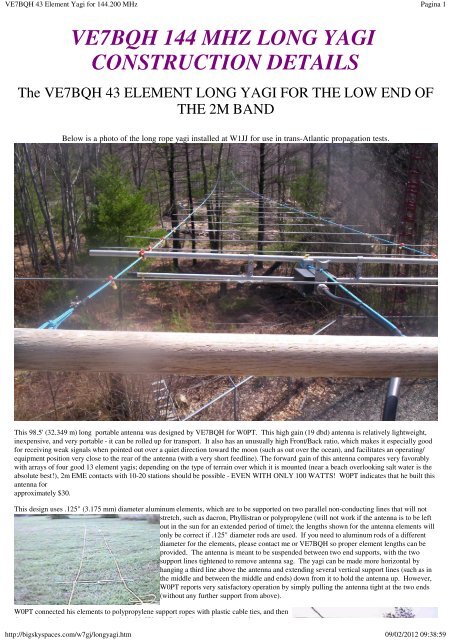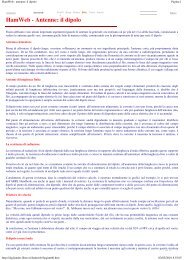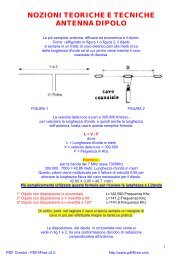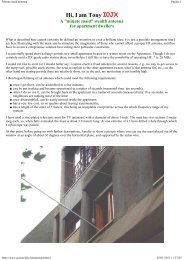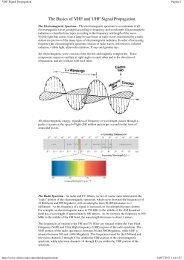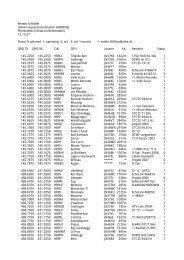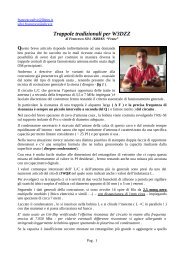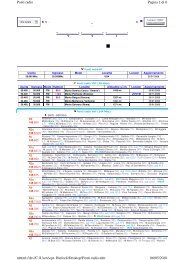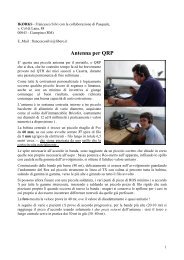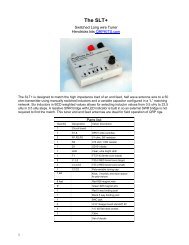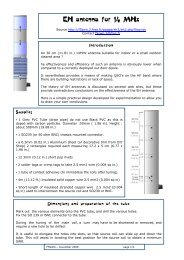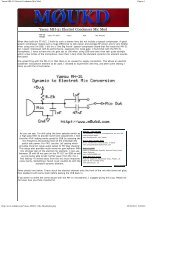VE7BQH 43 Element Yagi for 144.200 MHz - IN3ECI
VE7BQH 43 Element Yagi for 144.200 MHz - IN3ECI
VE7BQH 43 Element Yagi for 144.200 MHz - IN3ECI
Create successful ePaper yourself
Turn your PDF publications into a flip-book with our unique Google optimized e-Paper software.
<strong>VE7BQH</strong> <strong>43</strong> <strong>Element</strong> <strong>Yagi</strong> <strong>for</strong> <strong>144.200</strong> <strong>MHz</strong><br />
Pagina 1<br />
<strong>VE7BQH</strong> 144 MHZ LONG YAGI<br />
CONSTRUCTION DETAILS<br />
The <strong>VE7BQH</strong> <strong>43</strong> ELEMENT LONG YAGI FOR THE LOW END OF<br />
THE 2M BAND<br />
Below is a photo of the long rope yagi installed at W1JJ <strong>for</strong> use in trans-Atlantic propagation tests.<br />
This 98.5' (32.349 m) long portable antenna was designed by <strong>VE7BQH</strong> <strong>for</strong> W0PT. This high gain (19 dbd) antenna is relatively lightweight,<br />
inexpensive, and very portable - it can be rolled up <strong>for</strong> transport. It also has an unusually high Front/Back ratio, which makes it especially good<br />
<strong>for</strong> receiving weak signals when pointed out over a quiet direction toward the moon (such as out over the ocean), and facilitates an operating/<br />
equipment position very close to the rear of the antenna (with a very short feedline). The <strong>for</strong>ward gain of this antenna compares very favorably<br />
with arrays of four good 13 element yagis; depending on the type of terrain over which it is mounted (near a beach overlooking salt water is the<br />
absolute best!), 2m EME contacts with 10-20 stations should be possible - EVEN WITH ONLY 100 WATTS! W0PT indicates that he built this<br />
antenna <strong>for</strong><br />
approximately $30.<br />
This design uses .125" (3.175 mm) diameter aluminum elements, which are to be supported on two parallel non-conducting lines that will not<br />
stretch, such as dacron, Phyllistran or polypropylene (will not work if the antenna is to be left<br />
out in the sun <strong>for</strong> an extended period of time); the lengths shown <strong>for</strong> the antenna elements will<br />
only be correct if .125" diameter rods are used. If you need to aluminum rods of a different<br />
diameter <strong>for</strong> the elements, please contact me or <strong>VE7BQH</strong> so proper element lengths can be<br />
provided. The antenna is meant to be suspended between two end supports, with the two<br />
support lines tightened to remove antenna sag. The yagi can be made more horizontal by<br />
hanging a third line above the antenna and extending several vertical support lines (such as in<br />
the middle and between the middle and ends) down from it to hold the antenna up. However,<br />
W0PT reports very satisfactory operation by simply pulling the antenna tight at the two ends<br />
(without any further support from above).<br />
W0PT connected his elements to polypropylene support ropes with plastic cable ties, and then<br />
the mechanical connections was sealed with "Plastic Rubber" to make sure the element<br />
http://bigskyspaces.com/w7gj/longyagi.htm<br />
09/02/2012 09:38:59
<strong>VE7BQH</strong> <strong>43</strong> <strong>Element</strong> <strong>Yagi</strong> <strong>for</strong> <strong>144.200</strong> <strong>MHz</strong><br />
Pagina 2<br />
W0PT connected his elements to polypropylene support ropes with plastic cable ties, and then<br />
the mechanical connections was sealed with "Plastic Rubber" to make sure the element<br />
locations would remain fixed. The intended use of this antenna is to provide gain in a specific<br />
direction, such as over a fixed tropo path or toward a particular azimuth where the moon is<br />
intended to rise or set. It can be steered somewhat (to adjust <strong>for</strong> the changing moon declination<br />
and corresponding change in azimuth of moonset or moonrise) by moving one end of the yagi (such as moving the end support point between two<br />
trees). In an ideal situation, the transmission line to the Driven <strong>Element</strong> can be kept very short, with the yagi extending out away from the<br />
operating position.<br />
NOTE: Be sure to mount the rope yagi at least 12' above the ground. Mounting it lower than this will cause excessive ground absorption, and<br />
loss of gain.<br />
<strong>VE7BQH</strong> <strong>43</strong> <strong>Element</strong> <strong>Yagi</strong> <strong>Element</strong> Layout<br />
ELEMENT<br />
OVERALL<br />
" DISTANCE<br />
ELEMENT<br />
FROM REFLECTOR<br />
LENGTH "<br />
Reflector 40.6152 0<br />
Driven <strong>Element</strong> * 12.2883<br />
Dir 1 38.2994 17.2507<br />
Dir 2 37.4868 26.4669<br />
Dir 3 36.7122 39.2276<br />
Dir 4 36.6674 55.0605<br />
Dir 5 36.1396 73.4928<br />
Dir 6 36.1004 94.2884<br />
Dir 7 35.8592 116.9742<br />
Dir 8 35.5766 141.3142<br />
Dir 9 35.5866 167.0723<br />
Dir 10 35.3840 194.0116<br />
Dir 11 35.2068 222.0145<br />
Dir 12 35.1176 250.7263<br />
Dir 13 35.0484 280.3835<br />
Dir 14 34.9630 310.6313<br />
Dir 15 34.8178 341.4701<br />
Dir 16 34.7270 372.8275<br />
Dir 17 34.6670 404.1849<br />
Dir 18 34.5640 <strong>43</strong>5.8144<br />
Dir 19 34.5058 467.7981<br />
Dir 20 34.4646 500.1359<br />
Dir 21 34.3994 532.5916<br />
Dir 22 34.2830 565.4014<br />
Dir 23 34.2564 597.9<strong>43</strong>3<br />
Dir 24 34.2092 630.3938<br />
Dir 25 34.2298 662.8316<br />
Dir 26 34.1738 695.3784<br />
Dir 27 34.0936 728.1672<br />
Dir 28 34.0068 760.7<strong>43</strong>0<br />
Dir 29 33.9732 793.0886<br />
Dir 30 34.0360 825.29<strong>43</strong><br />
Dir 31 34.0586 857.7106<br />
Dir 32 34.0776 890.7905<br />
Dir 33 34.0234 923.6640<br />
Dir 34 33.8996 956.4708<br />
Dir 35 33.9336 988.3597<br />
http://bigskyspaces.com/w7gj/longyagi.htm<br />
09/02/2012 09:38:59


